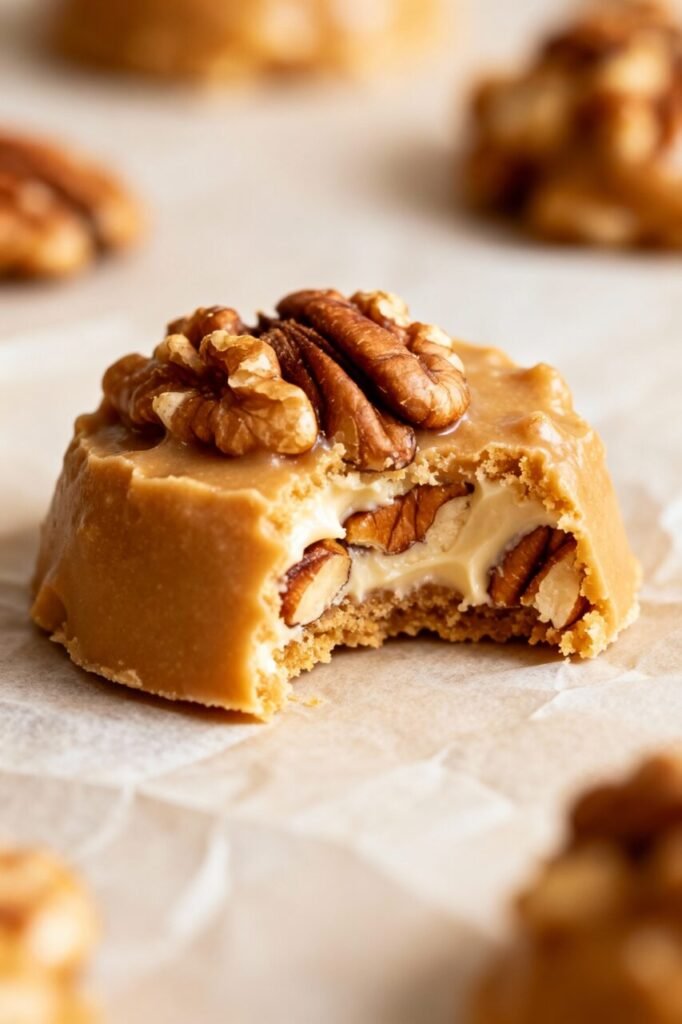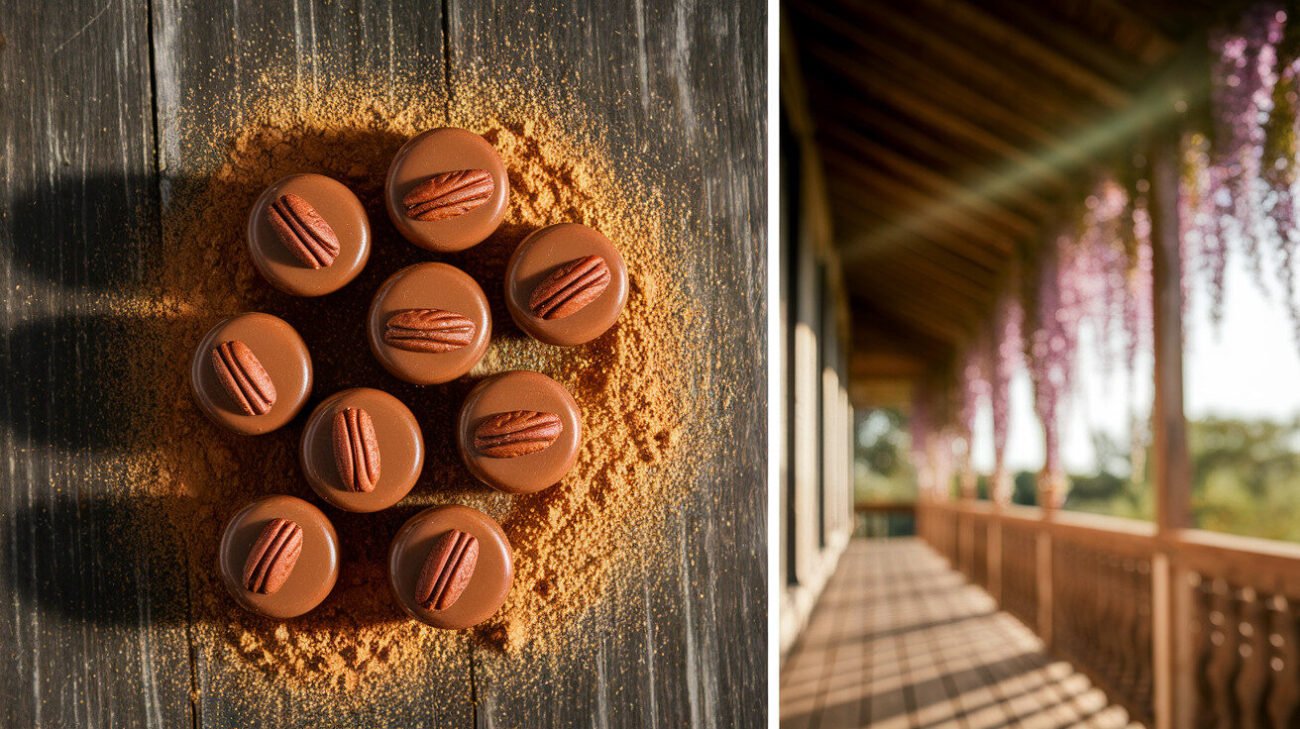Let’s be real—most keto candy recipes are… disappointing. They’re either weirdly grainy, have that distinct cooling effect from erythritol, or they just don’t capture the magic of the original. I’ve been there. After testing probably two dozen variations in my kitchen, I finally cracked the code. This keto pecan pralines recipe delivers that authentic, creamy-crunchy Southern texture without a single gram of sugar. The secret isn’t just swapping sweeteners—it’s understanding the chemistry of candy-making without sugar’s structural help.
Why These Keto Pralines Beat Traditional Sugar Bombs
Traditional pralines rely on sugar not just for sweetness but for creating that specific crystalline structure that gives them their unique snap and melt-in-your-mouth quality. When you remove sugar, you’re not just removing sweetness—you’re removing the foundation of the candy. Most failed keto pralines try to mimic this with just one sweetener, and that’s where they go wrong. You need a blend that can withstand heating to specific temperatures without crystallizing too much or too little.
The Secret to Authentic Texture Without Sugar
The texture comes down to two things: fat content and controlled crystallization. Traditional recipes use the sugar crystallization to create those tiny, meltaway crystals suspended in butter and cream. For keto, we achieve this through a precise ratio of allulose to erythritol. Allulose behaves remarkably like sugar when heated—it caramelizes beautifully and helps prevent the erythritol from recrystallizing into sandiness. The addition of grass-fed butter and heavy cream provides the rich mouthfeel that makes these feel indulgent rather than “diet.” I’ve found that using just a tablespoon of coconut flour acts as a stabilizer, absorbing excess moisture without making the pralines heavy.
How We Cracked the Keto Candy Code
It was honestly a process of elimination. I started with pure erythritol—grainy mess. Then pure allulose—never set properly. Through testing, I discovered that a 2:1 ratio of allulose to erythritol gave the best results. The allulose provides the pliable, chewy texture and caramel notes, while the erythritol contributes to the firm set and helps offset allulose’s slight moisture attraction. Adding a pinch of xanthan gum was the final breakthrough—it prevents the fat from separating during the cooking process, which used to frustrate me to no end.
Gathering Your Keto Praline Ingredients
Ingredients:
- 1 ½ cups raw pecans halves
- ½ cup allulose
- ¼ cup powdered erythritol (must be powdered)
- ½ cup heavy cream
- ¼ cup grass-fed butter (unsalted)
- 1 tbsp coconut flour
- ½ tsp vanilla extract
- ¼ tsp xanthan gum
- Pinch of sea salt
The Sweetener Showdown: Choosing Your Keto Foundation
This is non-negotiable: you need both allulose and erythritol. Allulose is the workhorse here—it’s about 70% as sweet as sugar but browns and behaves like sugar when heated. It’s what gives you that gorgeous caramel color and prevents the sandy texture. The powdered erythritol adds bulk and helps with the set. Don’t use granular erythritol—it won’t dissolve properly and you’ll end up with gritty pralines. I’ve tested with BochaSweet and monk fruit blends too, but this specific combination gives the most reliable results across different humidity conditions.
Picking the Perfect Pecans for Maximum Flavor
You want raw pecan halves, not pieces. The pieces have more surface area and can burn more easily during toasting. Look for plump, uniform halves without any visible oil residue (which indicates they’re going rancid). Toasting them first is crucial—it brings out their natural oils and prevents them from becoming soggy when mixed with the hot candy syrup. I spread them on a baking sheet at 350°F for 6-8 minutes until fragrant. Under-toasted pecans taste bland; over-toasted ones bring bitterness that clashes with the sweet caramel notes.
The Critical Role of Dairy and Fats
Grass-fed butter has a higher fat content and richer flavor than regular butter, which matters when it’s such a prominent ingredient. The heavy cream should be the real deal—not half-and-half or, heaven forbid, anything labeled “cream product.” The fat content stabilizes the emulsion and creates that luxurious mouthfeel. I’ve tried with coconut cream for dairy-free, but the results are different—still good, but not quite the same classic praline experience. The dairy proteins also contribute to the Maillard reaction during cooking, developing those complex caramel flavors.
Step-by-Step Keto Praline Perfection
Instructions:
- Prep: Line a baking sheet with parchment paper. Toast pecans at 350°F for 6-8 minutes until fragrant, then set aside.
- Combine Base: In a medium saucepan, combine heavy cream, butter, allulose, and powdered erythritol. Cook over medium heat, stirring constantly with a wooden spoon, until butter melts and sweeteners dissolve completely.
- Cook to Temperature: Attach a candy thermometer to the pan. Continue cooking without stirring until mixture reaches 235°F (soft-ball stage). This should take about 8-12 minutes.
- Combine Remaining Ingredients: Remove from heat. Immediately whisk in coconut flour, xanthan gum, vanilla, and sea salt until fully incorporated and smooth.
- Add Pecans: Fold in toasted pecans until evenly coated.
- Scoop and Set: Working quickly, drop tablespoon-sized portions onto prepared parchment paper. If mixture becomes too thick to scoop, gently reheat for 15-20 seconds.
- Cool Completely: Let pralines set at room temperature for 45-60 minutes until firm. Do not refrigerate to set.



Mastering the Sugar-Free Syrup Stage
The “soft-ball stage” is everything here. With sugar, you’d be looking for 235-240°F. With our keto sweeteners, I’ve found 235°F to be the sweet spot—literally. The allulose will have started to caramelize, giving you that beautiful amber color. Don’t walk away during this stage—it can go from perfect to burned surprisingly fast. And please, use a real candy thermometer. Those infrared ones aren’t reliable for syrup temperatures because they measure surface temperature, not the temperature throughout the liquid. This is one area where guessing just doesn’t work.
The Tell-Tale Signs of Perfect Setting Point
Besides the temperature, look for visual cues. The syrup should thicken noticeably and coat the back of your spoon. When you drizzle a bit back into the pan, it should ribbon rather than immediately sink in. The color should be a light caramel—think honey rather than maple syrup. If you see any dark streaks, that’s your sign to pull it off the heat immediately. The residual heat will continue cooking it, so I always take it off at 234°F and let the carryover heat bring it that last degree.
Spreading and Setting Like a Pro
Work quickly once you’ve removed the syrup from heat. The xanthan gum and coconut flour will start thickening the mixture as it cools. I use a small cookie scoop (about 1 tablespoon size) for uniform pralines. If the mixture becomes too thick to scoop comfortably, you can gently rewarm it over low heat for 15-20 seconds, stirring constantly. Don’t try to shape them too much—just drop them and let them spread naturally. They’ll firm up into that classic praline shape as they cool.
Troubleshooting Common Keto Candy Issues
- Grainy texture: Usually means your erythritol wasn’t powdered finely enough or didn’t dissolve completely. Always use powdered and make sure it’s fully dissolved before stopping to stir.
- Too soft/never sets: Likely didn’t reach temperature or your humidity is too high. Keto candies are more sensitive to humidity than sugar-based ones.
- Butter separation: Means you heated too quickly or didn’t incorporate the xanthan gum properly. Whisk vigorously when adding the dry ingredients.
- Burnt taste: Heat was too high. Medium heat is your friend here—patience pays off.

Frequently Asked Questions
What’s the best keto sweetener for pralines?
Hands down, the allulose-erythritol blend I’ve outlined. Allulose behaves most like sugar in candy-making because it caramelizes and doesn’t recrystallize. Pure monk fruit or stevia extracts are too potent and can bring bitter notes when heated. Pure erythritol alone makes grainy pralines. The combination gives you the best of both worlds—proper texture and clean sweetness without aftertaste.
Why won’t my keto pralines set properly?
Two main culprits: either you didn’t reach the proper temperature (235°F), or it’s too humid. Keto candies are hygroscopic—they absorb moisture from the air. If your kitchen humidity is above 60%, they might stay tacky no matter what. In that case, you can try setting them in a dehydrator on the lowest setting, or just accept they’ll be more of a praline sauce (which is still delicious over keto ice cream!).
How do I store keto pralines to keep them fresh?
In an airtight container at room temperature, with parchment between layers. Do not refrigerate—the moisture in the fridge will make them sticky. They’ll keep for about a week this way. For longer storage, freeze them in a single layer first, then transfer to an airtight container. They’ll keep for 2-3 months frozen. Thaw at room temperature still wrapped to prevent condensation.
Can I use other nuts instead of pecans?
Absolutely. Walnuts work beautifully—they have a similar oil content and crunch. Macadamia nuts are fantastic if you want something truly decadent (though higher in carbs). Almonds work but have a harder crunch that doesn’t quite mimic traditional pralines. Just make sure whatever nut you use, you toast it first. It makes a world of difference.
Are these pralines actually low-carb?
Each praline (recipe makes about 18) has approximately 1.5g net carbs. The carbs come mainly from the pecans and small amounts from the dairy and coconut flour. Compare that to a traditional praline at 15-20g of sugar each, and yes, they’re absolutely low-carb. I calculate using the specific brands I use, so your numbers might vary slightly.
How long do keto pralines last?
About 1 week at room temperature in airtight conditions. The allulose does tend to attract moisture over time, so they might become slightly softer as days pass. They don’t really “spoil” in the traditional sense, but the texture deteriorates. Honestly though? In my house, they’ve never lasted more than three days.
Can I double this recipe successfully?
I wouldn’t. Candy-making is precise, and doubling the batch means it will take much longer to reach temperature, potentially overcooking the ingredients. The syrup volume also makes it harder to get an accurate temperature reading. If you need more, make separate batches. It’s worth the extra 15 minutes for guaranteed results.
Why did my pralines become grainy?
This is almost always an erythritol issue. Either it wasn’t powdered finely enough, or it didn’t fully dissolve during the initial heating stage. Make sure you’re using commercially powdered erythritol (I run mine through a coffee grinder even if it says “powdered” to be extra sure), and don’t stop stirring during the initial dissolution phase until you can’t feel any grittiness when you rub the syrup between your fingers.



